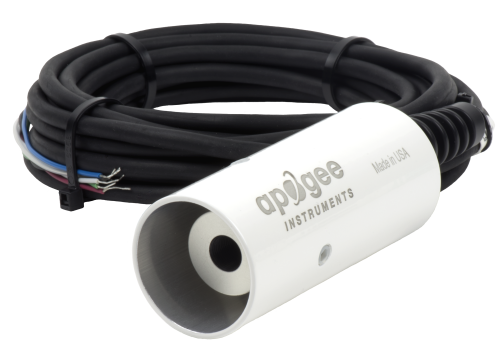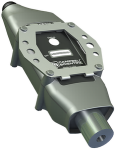Ce produit n'est plus disponible et a été remplacé par: SI-111SS. Certains accessoires, pièces de rechange ou des services peuvent être encore disponibles.

| Services disponibles |
|---|
Aperçu
The SI-111, manufactured by Apogee, is a precision infrared radiometer that determines the surface temperature of an object without physical contact. It measures both the subject's surface temperature and the sensor-body temperature. A Campbell Scientific datalogger uses these measurements to calculate the correct temperature of the subject.
Lire la suiteAvantages et caractéristiques
- Compatible with most Campbell Scientific data loggers
- Measures surface temperature continuously in the field
- Provides road surface, plant canopy, soil surface, snow surface, and water surface temperature measurements
- Avoids influencing the temperature, providing more accurate measurements
- Ideal for providing spatial averages
- Rugged construction—two temperature probes housed in an aluminum body with a germanium window
Images






Description technique
The SI-111 consists of a thermopile, which measures surface temperature, and a thermistor, which measures sensor body temperature. The two temperature sensors are housed in a rugged aluminum body that contains a germanium window.
Both the thermopile and the thermistor output a millivolt signal that most of our data loggers can measure. The data logger uses the Stefan-Boltzman equation to correct for the effect of sensor body temperature on the target temperature. The corrected readings yield an absolute accuracy of ±0.2°C from -10° to +65°C.
Field of View (FOV)
The SI-111 has a 22-degree half-angle field-of-view (FOV). The FOV is reported as the half-angle of the apex of the cone formed by the target (cone base) and the detector (cone apex). The target is a circle from which 98% of the radiation viewed by the detector is being emitted.
Note: Prior to November 2008, the SI-111 was named the IRR-P.
Spécifications
| Input Power | 2.5 V excitation (for thermistor) |
| Response Time | < 1 s (to changes in target temperature) |
| Target Temperature Output Signal | 60 μV per °C difference from sensor body |
| Body Temperature Output Signal | 0 to 2500 mV |
| Optics | Germanium lens |
| Wavelength Range | 8 to 14 μm (corresponds to atmospheric window) |
| Field of View (FOV) | 22° half angle |
| Operating Temperature Range | -55° to +80°C |
| Operating Relative Humidity Range | 0 to 100% RH |
| Cable Description | 4.5 m (14.76 ft) twisted, shielded 4-conductor wire with Santoprene casing, ending in pigtails |
| Absolute Accuracy |
|
| Uniformity |
|
| Repeatability |
|
| Diameter | 2.3 cm (0.9 in.) |
| Length | 6 cm (2.4 in.) |
| Weight | 190 g (6.7 oz) |
Compatibilité
Veuillez noter : Ce qui suit montre des informations de compatibilité générales. Ce n'est pas une liste complète de tous les produits compatibles.
Centrale de mesure
| Produits | Compatibilité | Note |
|---|---|---|
| CR1000 (obsolète) | ||
| CR1000 (obsolète) | ||
| CR1000 (obsolète) | ||
| CR1000 (obsolète) | ||
| CR1000 (obsolète) | ||
| CR1000 (obsolète) | ||
| CR1000 (obsolète) | ||
| CR1000 (obsolète) | ||
| CR1000 (obsolète) | ||
| CR200X (obsolète) | ||
| CR216X (obsolète) | ||
| CR300 | ||
| CR3000 (obsolète) | ||
| CR310 | ||
| CR5000 (obsolète) | ||
| CR6 | ||
| CR800 (obsolète) | ||
| CR850 (obsolète) | ||
| CR9000X (obsolète) |
Informations de compatibilité supplémentaires
Mounting
The SI-111 is often fastened to a CM200-series crossarm, a tripod or tower mast, or a user-supplied pole using a CM230, CM230XL, or CM220 mount. The CM230 and CM230XL are adjustable inclination mounts that allow the SI-111 to be mounted perpendicular to the target surface when the target surface is on an incline. The CM230XL is similar to the CM230, but the CM230XL places the SI-111 further from the pole or crossarm. The SI-111 may also be attached directly to a user-supplied camera tripod.
Documents à télécharger
Applications
FAQ
Nombre de FAQ au sujet de(s) SI-111: 8
Développer toutRéduire tout
-
As a general recommendation, recalibration should be done every two years.
-
The window in the Apogee infrared sensor is inset and protected, but it can become partially blocked in three ways:
- Spiders can make a nest in the entrance. Campbell Scientific recommends using a cotton swab to apply a spider repellent around the entrance to the aperture. Do not apply the repellent, however, to the sensor window itself.
- Calcium deposits can accumulate on the window if irrigation water sprays up on the head. These deposits typically leave a thin white film on the surface, which can be removed with a diluted acid, such as vinegar. Calcium deposits cannot be removed with solvents such as alcohol or acetone.
- In windy environments, dust and dirt can be deposited in the aperture. The aperture can be cleaned with deionized water, rubbing alcohol, or in extreme cases, acetone.
Clean the inner threads and sensor window using a cotton swab dipped in the appropriate solvent. For additional cleaning information, see the Maintenance section of the instruction manual.
-
There are two accuracy specifications listed for the SI-111:
- One for when the difference in the target and sensor body temperatures is less than 20°C (more accurate)
- One for when the difference in the target and sensor body temperatures is greater than 20°C (less accurate)
Using a radiation shield with the sensor helps keep the sensor body temperature in close approximation to the ambient air temperature. Ultimately, the need to protect the sensor from short-wave radiation is dependent on what is being measured and under what conditions. For example, Campbell Scientific recommends using a radiation shield for canopy measurements.
-
The SI-111 can be used to measure a wide variety of surfaces, including water and snow. When measuring objects with low emissivity, however, it is particularly important to apply corrections to the measurement.
-
The SI-111 has been successfully calibrated with a maximum cable length of 100 m without a loss in accuracy. Ideally, the sensor is calibrated with the overall cable length already configured. Our tests have shown, however, that adding a few meters of cable in the field has a negligible effect on the calibration, provided the measurement device has significantly high input impedance, such as with the CR1000.
-
En raison de la perte de rayonnement IR, presque tous les instruments à thermopiles ont généralement un décalage négatif. Ce décalage est le plus facilement visible la nuit, quand une petite valeur négative est lue au lieu de zéro. Ce même décalage est présent pendant la journée, mais il n'est pas aussi visible à cause de l'importance du signal solaire.
Un autre problème commun concerne la mise à niveau d'un instrument. La mise à niveau d'un instrument de thermopile peut entraîner des erreurs dans la composante du faisceau direct car la réponse en cosinus n'est pas correcte. Ces erreurs sont plus notables lorsque le soleil est proche de l'horizon car l'angle est peu profond.
-
Les informations contenues sur une feuille d'étalonnage diffère entre chaque capteur. Pour certains capteurs, la feuille contient des coefficients nécessaires pour programmer une centrale d'acquisition de données. Pour les autres capteurs, la feuille d'étalonnage est un rapport de réussite/échec.
-
Cela dépend de l'information contenue dans la feuille d'étalonnage :
- Si la feuille d'étalonnage contient des coefficients d'étalonnage, Campbell Scientific conserve une copie, et une copie de remplacement peut être demandée.
- Si la feuille d'étalonnage ne contient pas de coefficients, Campbell Scientific ne conserve pas de copie. Il peut être possible de contacter le fabricant pour une copie.
Applications
Overview In the fight against climate change, innovative solutions are emerging to address the global challenge......En savoir plus
Cette étude de cas traite de l'intégration des systèmes CPEC310 et AP200 pour explorer les......En savoir plus
La problématique - Comment optimiser les performances d'un toit végétalisé Le laboratoire d'essais d'innovation Green Roof......En savoir plus
Comprendre les échanges d'énergie, d'eau et de dioxyde de carbone entre l'atmosphère, la terre et......En savoir plus
La culture et l'exportation de roses et autres fleurs est une entreprise énorme en Colombie.......En savoir plus
Articles et Communiqués de presse
Articles du Blog
-
Minimize Losses from Frost Using Direct Measurements

08-02-2017 Auteur : Dirk Baker






